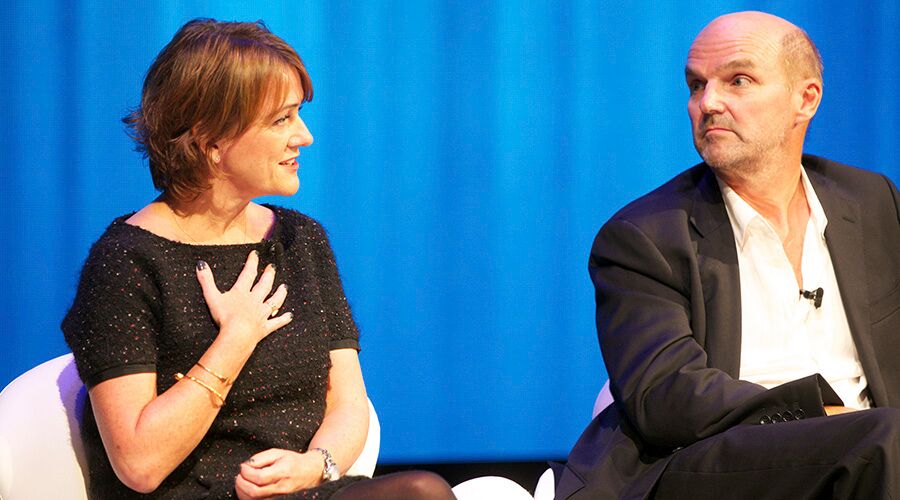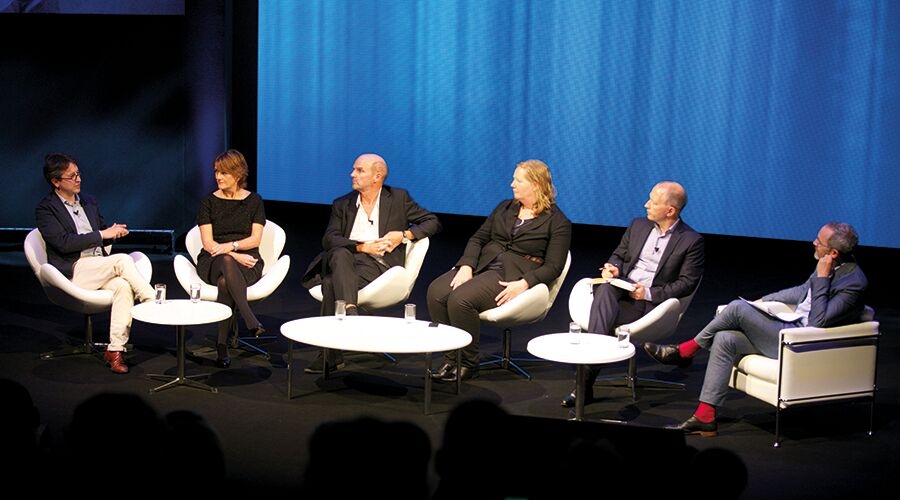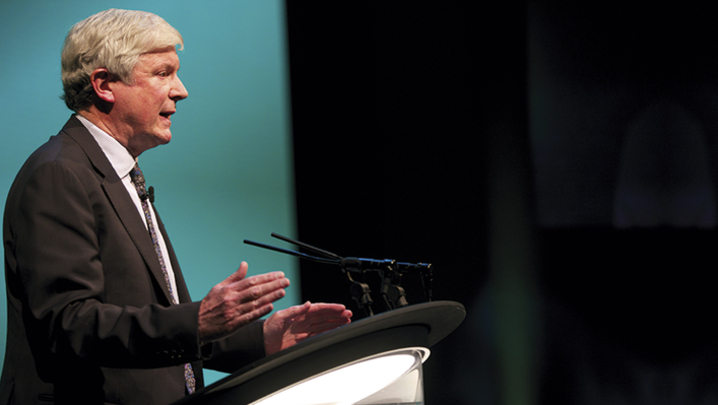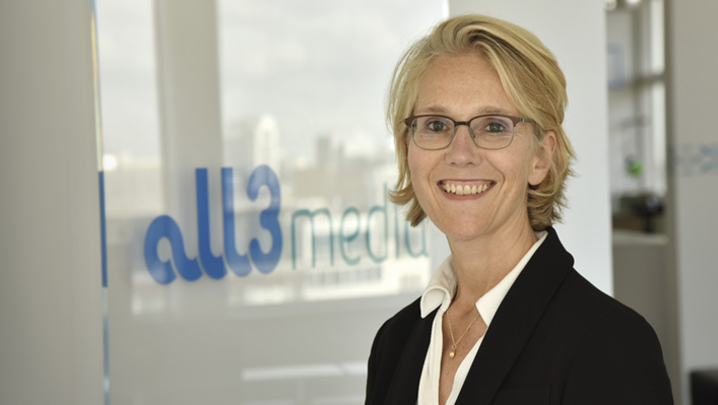Cambridge Convention 2015 Session One: A stellar panel discusses what today’s trends tell us about the state of the TV industry in five years’ time.
Who will own the future – the broadcasters, the content owners or the global tech behemoths, such as Google, Facebook and Apple? The question is not new, but it is becoming ever more pressing for people in television.
James Purnell, the BBC’s Director, Strategy and Digital, led this comprehensive opening debate, “Happy Valley or House of Cards? Television in 2020”.
To say that Cambridge 2015 hit the ground running would be something of an understatement. The audience was treated to a wide range of perspectives as they waited to discover who would be the Masters of the Universe in five years’ time.
There were encouraging words for the established TV players, as Cassian Harrison, Editor, BBC Four, provided an erudite preamble to the panel discussion. “We all still love traditional TV,” he said. “For all the proliferation of new devices, we still watch TV by far the most.”
This, however, was only part of a story with more plot twists than an episode of Sherlock and more data than a Barb spreadsheet. Everybody knows that the TV screen now competes for our time alongside mobiles, tablets and games consoles.

The box may be the most popular screen in people’s homes, but it is no longer used solely to watch television or even TV shows.
The long-term future of TV perhaps belongs to apps, as Apple recently suggested. Yet, for the foreseeable future, time-honoured TV channels look like a safe bet.
“Running BBC Four, I know that channels are an incredibly efficient way to reach passionate parts of your audience,” stressed Harrison.
He added: “The big tech players can see the appeal of a curated channel, too. Apple Music launched off the back of a traditional, curated music station. Vice has its own linear broadcast channel. Twitter’s Project Lightning is bringing manual curation to social media.”
Nevertheless, future growth is expected to come largely from mobile viewing and on-demand platforms funded by advertising. YouTube, Facebook and Snapchat are all predicted to grow fivefold by 2020, noted the BBC executive (see below).
“Who would have thought that a messaging app would become a major VoD platform?” pondered Harrison. Who, indeed? Snapchat is worth a cool $10bn or more, despite having launched a mere four years ago. Crowdfunding platform Kickstarter is one of the biggest funders of documentaries, globally.
In other words, there is no shortage of US online success stories. Alongside this phenomenon exists an equally intriguing, if hardly new, development – US media giants’ enthusiasm for buying British producers.
The ownership of valuable intellectual property is, arguably, more important than ever in this crowded and confusing multi-screen world, suggested production boss Stephen Lambert, as the panel debate commenced.
Lambert’s company, Studio Lambert, is part of All3Media, bought jointly last year by Discovery and Liberty Global for a reported £500m.
Rather prosaically, Purnell asked Lambert if programming-making had altered in the light of technological change. Essentially, it hadn’t – although hit shows were more elusive than ever, suggested Lambert. “The biggest challenge is coming up with an idea that works,” opined the veteran producer and reality-show specialist. “It is harder than ever to have a hit.”
He added: “In US TV, particularly in non-scripted, there hasn’t been a hit for ages. This summer, 12 new non-scripted shows launched on US broadcasters. They all failed, with the possible exception of Celebrity Family Feud.
“Britain is still the place where we think it is easier to come up with a new idea and get it away,” he claimed. “The growth of the new services and viewing over broadband changes things so much… I don’t know whether that means the UK will end up on a similar trajectory to America.”
One thing is becoming clear – in a connected world, many of the audience, particularly younger viewers, are increasingly promiscuous in their content consumption. Discovery’s Susanna Dinnage highlighted what she regarded as the “polarisation” of viewing behaviour.
At one end of the spectrum was the “slightly exaggerated importance of live sport”, where watching via catch-up was not an option, and, by contrast, “snap judgements” on new shows. As a result, there were few opportunities for new ideas to find a following.
“If you’re breaking new talent, you need time,” she said. “We find, particularly with younger audiences, that you’ve got to get them in the first three minutes.
“Somebody said to me the other day: ‘Technology isn’t the be-all and end-all, but it makes it very easy to break up with you’.”
“The biggest challenge is coming up with an idea that works”
Dinnage warned: “There are millions of other places the audience can go to… As broadcasters, we need to be very thoughtful about how committed we are to just sitting with things, keeping investing in series we believe in and talent that we want to grow, and hope that the audience will come back and trust us.”
The broadcasters’ loss looks like a gain for on-demand platforms. YouTube’s Stephen Nuttall claimed the Google-owned service was experiencing “the fastest growth we’ve had for several years” – an astonishing 70%, or so, year on year. Viewership on mobile was up by more than 100%.
“We welcome competition,” he stressed. “Around 40% of video watched on YouTube is long-form content. So there is a big shift in the type of content people are consuming.”
Purnell asked if YouTube’s market was the same as the broadcasters’. “We are very focused on what users want to watch,” replied Nuttall. “We are trying to create platforms for storytellers, who can reach a global audience.”
Lambert, perhaps fearing extinction, inquired if many people gathered together on the sofa to watch YouTube? Perhaps he had an idea for a future edition of Gogglebox.
“No, but the fastest-growing screen for us is the TV screen,” said the YouTube executive. “It could be someone watching via a games console, their Virgin Media box or via Chromecast.”
Delegates sensed that the panel was getting to the heart of the debate. It was time to canvas the view of an independent observer. Purnell wanted to know if Emily Bell, the ex-Guardian high-flyer reinvented as a professor at the prestigious Columbia University Journalism School, thought TV was experiencing the same challenges as newspapers confronted around 2005.
“Yes and no,” was Bell’s verdict. “You have more money, journalism never really made money. It has always relied on cross-subsidy. People don’t like to advertise against things that are ugly and true.
“But there are very strong parallels…From my perspective, some of the conversations that are being had in television now are very similar to the conversations newspapers had about a decade ago.
“It is great to have someone here from YouTube, saying that he welcomes competition, because, in terms of distribution platforms, the world is moving towards a very small number of extremely powerful players,” Bell added passionately (see box, lower right).
“If you look at the market capitalisation of Goggle, Facebook, Amazon and Apple, it is already clear who has won.
“Access to capital is going to be very tough.… Broadcasters need to get rid of their legacy costs. That’s one lesson from the news industry. The other is to stick to your storytelling skills.”
But even if you’ve got brilliant storytelling skills in TV, it is still hard to make money out of it, Purnell suggested. Kickstarter may be raising millions, but that is a very different model. Would storytelling skills offer protection against the global ecosystems, asked Tony Hall’s right-hand man?
Silicon Valley investor Benedict Evans pointed out that, with so many choices of what and how to watch, the creative process itself would be transformed. The sheer volume of choices raised new problems around distribution.
“There is now vastly more TV than there is time to watch it. You used to have a schedule and an EPG that was regulated…
“It’s not that you change how you make programmes… but how you get people to watch them. That, in turn, shapes what kind of shows get made and who might be making them.”
Gamely, Purnell inquired if the answer to that problem was, er, channels? “Yes, but there are new aggregation models as well.… Look at the success of Snapchat. It could be an app.”
For YouTube, search and recommendation were more important than channels, noted Nuttall. “The fact is that most channels [on YouTube] probably generate only 5% to 10% of viewership for that content creator,” he said.
Purnell stressed that 85% of television viewing was still of live, linear TV. Dinnage, however, sensed that, for broadcasters, their brand was becoming more important than their channels per se.
Strong brands “take a heck of a long time to build, but you can break them overnight”, she reckoned. “Most broadcasters have been around for 25-plus years. We don’t take lightly the relationship we have with our viewers. It will be interesting to see how quickly the new arrivals can build that relationship and how long that trust can last.”
This, perhaps, was missing the point of how users access content online, countered Evans. “It comes back to the unbundling question,” he said. “You may go to the aggregator to see the story, or you may just search for the story or the show, or the show may be recommended to you by a friend.”
In this world, the kind of content that dropped off a cliff was “middling stuff”, scheduled, perhaps, at 5:00pm on a Sunday afternoon. “All that stuff that doesn’t quite work on its own, but works because of the channel, that’s the thing that falls away,” emphasised Evans.
Dinnage said that the power of storytelling remained paramount, regardless of the platform. And in any case, broadcasters needed to challenge the amount of viewing claimed by new entrants and their definitions of viewing.
Seeing a video for a few seconds as you scroll down a Facebook page is not the same as watching an entire TV programme. “TV viewing is measured in a very transparent way. We take pride in that,” said the Discovery executive. “If we are all going to play in the same park, let’s have agreed definitions of what constitutes viewing.”
If everything was measured in a common currency, would broadcasters then have nothing to worry about, asked Purnell.
Lambert said that no one on the panel was arguing that TV was facing the firing squad. The questions were around financing it and distribution models. “If you can just get a broadband connection and see all those apps, why bother paying for Virgin or Sky. It’s people like that who face the biggest challenge.”
TV is, arguably, uniquely placed to move people, suggested Dinnage, although broadcasters must avoid complacency: “We are very good at making people feel and making people laugh.… We need to think how to take that to the next level. We are experimenting with virtual reality… smell and touch…
“If we’re really about enhanced experience, then we’ve got to take good storytelling on, never forgetting that our core excellence is good storytelling.”
Delegates had listened hard to the arguments. It was time to vote. So who would own the future – broadcasters, content owners or the global technology giants? The verdict was not good news for the likes of the BBC, ITV and Channel 4.
In first place were Google and its peers, on 30%; content creators nailed the second spot, on 28% – and a long way behind came the broadcasters, on just 10%.
It is worth remembering, however, that pundits have been writing traditional TV’s obituary for at least 20 years.
The panellists were: Emily Bell, Professor of Professional Practice and Director of Tow Center for Digital Journalism, Columbia University Journalism School; Susanna Dinnage, EVP and MD, Discovery Networks UK & Ireland; Benedict Evans, Partner, Andreessen Horowitz; Stephen Lambert, CEO, Studio Lambert; and Stephen Nuttall, Senior Director, YouTube EMEA. The session was chaired by James Purnell, Director, Strategy and Digital, BBC. It was introduced and produced by Cassian Harrison, with Jean-Paul Petranca and David Bunker.
How we use our screens
- Smartphones outnumber TV sets two to one
- The amount of mobile viewing is doubling every year
- By 2017, we might all be watching three hours of mobile video daily
- More than half of children prefer to watch video on a phone or tablet than on a TV
- Forty-one per cent of parents say their children would choose their tablet over eating dessert
- More than half of us watch videos on our phones while watching TV
- Among adults, 12% of TV use is for games, VoD and PVR recordings; it is 25% for young people
- On an average Saturday night, 3.3 million people in the UK are watching something other than TV on their TV sets
Why the outlook is bright for TV...
- The top 20 shows in the UK and US last year were all local shows. In the UK, the list is strikingly diverse, embracing drama, talent shows and The Great British Bake Off
- It is predicted that 10,000-plus new broadcast channels will launch in the next 10 years
And why it isn’t
- YouTube’s global audience averages 47 million every hour of the day or night
- Usage of VoD, S-VoD (Netflix, Amazon Prime et al) and ad-funded VoD (YouTube, Facebook, Snapchat) are all predicted to grow five-fold by 2020
Would a subscription-VoD car show pay its way?
Could a hypothetical, high-budget car show make money for a subscription video service such as Amazon Prime?
If a fictional Top Car series was commissioned by an S-VoD player for $250m over three years, it would need to return $83m annually, minus, say, $24m or 25m a year from DVD sales and merchandising rights.
How many new UK subscribers, paying $124 each, would the service need to attract? After deducting overhead costs of $65 each, the company would need to sign up 1 million new subscribers, each contributing $59 to the show.
Top Car needs to attract 15% of UK S-VoD households – but only 0.3% of households worldwide – to break even.
Do the tech behemoths block entry to potential rivals?
Yes, they do, said Emily Bell. It was now almost impossible to compete against Google because it was so big and had such easy access to capital.
This was a problem that could not be solved without some kind of regulatory intervention.
Not true, said Benedict Evans. The thing that had fundamentally changed with the rise of the internet over the past 20 years was that new entrants didn’t need any capital.… It was now incredibly easy to build something very big.... Facebook bought Instagram and WhatsApp and then Snapchat came along.
The idea that the door was now shut was just wrong. There was no a winner-takes-all dynamic at play.




